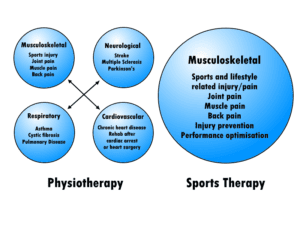What is a Sports Therapist:
A growing number of practitioners refer to themselves as Sports Therapists. In a world full of physiotherapists, osteopaths, sports massage therapists…It is a title that may not always be clear to the general public. So, I wanted to write a quick post to address a few points:
- What is a sports therapist?
- What’s the difference between a sports therapist and a physiotherapist?
- What’s the difference between s sports therapist and a sports massage therapist?
Summary:
Graduate Sports Therapist is similar to an musculoskeletal Physiotherapist. However, physiotherapists also cover cardiovascular, neurological, and respiratory medicine.
Sports Massage Therapists often go by the title Sports Therapist. However, it is important to check level of qualification, sports massage therapists should never be offering a diagnosis.
What is a Sports Therapist.
A graduate Sports Therapist, who is a Member of The Society of Sports Therapists, is an allied health professional who has the knowledge, skills and ability to:
· utilise sports and exercise principles to optimise performance, preparation and injury prevention programmes.
· provide the immediate care of injuries and basic life support in a recreational, training, occupational & competitive environment.
· assess, treat, rehabilitate and, where and if appropriate, refer on for specialist advice and intervention.
· provide appropriate soft tissue interventions in a sport & exercise context.
· plan and implement appropriate rehabilitation and return to training/work programmes.
To be registered with the Society of Sports Therapists, a practitioner must be qualified to degree level with a BSc or an MCs in Sports Therapy.
What is the difference between a Sports Therapist and a Physiotherapist?
Both sports therapists and physiotherapists are trained to treat musculoskeletal disorders. Dealing with pain and injury via hands on treatment and exercise therapy to rehabilitate and return to function. Both sports therapy and physiotherapy aim to restore, maintain and maximise movement, and increase quality of life.
Both sports therapists and physiotherapists are trained to:
- Assess and diagnose injury.
- Create treatment plans to maximise physical function.
- Implement rehabilitation programmes.
- Advise patients on healthy lifestyle habits.
But there are some key differences in the two professions:
- Physiotherapists have a broader knowledge base, which also takes in cardiovascular, neurological and respiratory arms of physiotherapy. Sports Therapy is focused primarily on the musculoskeletal rehabilitation element of health and illness.
- Sports Therapists often have more covered in sporting environments and exercise-based therapy during university, which builds a good competency of returning patients to their required level of physical performance.
What’s the difference between a sports therapist and a sports massage therapist?
This is where a lot of confusion often comes in for the general public. Unlike
Physiotherapy, which is a protected title (meaning, only people with an accredited qualification can go by this title), Sports Therapy is not protected. This means that any practitioner can go by the title ‘Sports Therapist’.
Often, sports massage therapists will assume the title of Sports Therapist. In this scenario it is important for the public to understand the key differences between a graduate Sports Therapist and a Sports Massage Therapist.
- The key difference is the scope of practice between the two professions. Sports Massage Therapists are trained primarily in using various massage techniques as a tool to reduce the feeling of tightness and muscular aches and pain.
- Graduate Sports Therapists may incorporate sports massage techniques into their treatment plan, but sports massage is just one small part of what a graduate sports therapist is trained to do. They are also trained to assess, diagnose and rehabilitate musculoskeletal injuries and conditions.
- Sports Massage Therapists are not qualified to diagnose musculoskeletal injuries and conditions.
Both professions can be very helpful in many ways, and some people’s cases may suit one or the other better. However, as this post highlights, it is important to
understand what qualification a therapist holds so you can understand the scope of their practice. Ensure your therapist is Qualified and Insured for what they are doing. As even well-meaning advice that is given outside of the scope of a practitioner’s qualification may be inaccurate and potentially
harmful.
A ‘diagnosis’ from the practitioner operating out of their scope of practice could potentially miss serious medical ref flag conditions that they aren’t trained to assess. This could lead to serious health implications. For example, a sports massage therapist may make the suggestion that back or abdominal pain is related to a ‘tight’ or ‘restricted’ tissue, without first screening conditions such as tumour, abdominal aortic aneurysm, cauda equina syndrome – all of which could have catastrophic consequences.
I hope that reading this article helps to clear up any confusion you may have surrounding the different professions and on who you may be best suited to visiting!
Please get in touch with any questions and hopefully we can see you soon at any of the Central Therapy locations; Melton Mowbray, West Bridgford, or Lowdham.
(image taken from rowanwoodsportstherapy.co.uk/)




